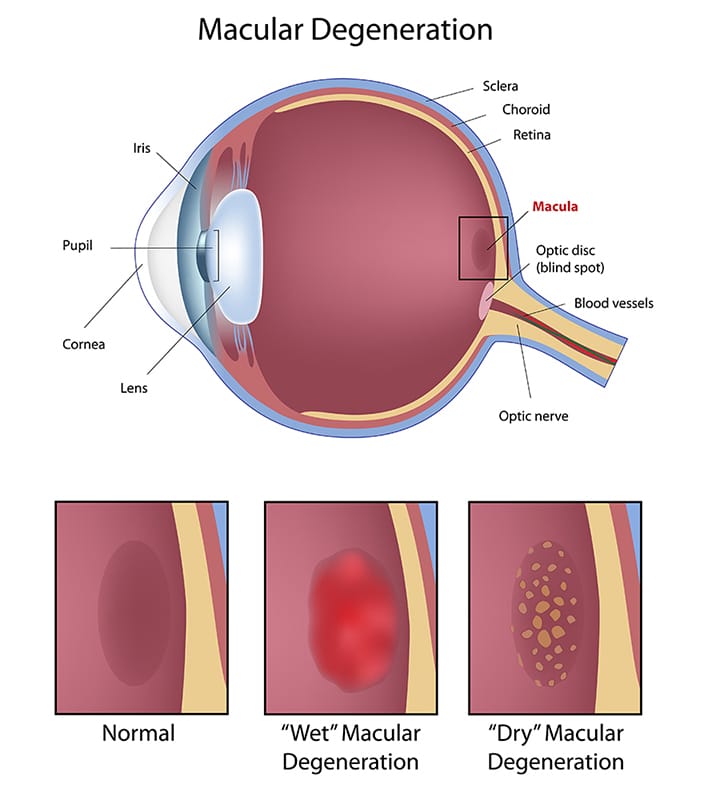Macular degeneration, also known as age-related macular degeneration (AMD), is a common condition in older adults and the leading cause of vision loss in people age 50 and older. Macular degeneration affects the macula, the part of the retina responsible for the crisp, detailed central vision needed for reading or driving.
Types Of Macular Degeneration
Macular degeneration can be classified as either dry (non-neovascular) or wet (neovascular). Dry macular degeneration is the more common diagnosis, and is considered to be an early stage of the disease. This form of the disorder usually develops as the macular tissues thin during aging. Deposits of pigment within the macula may also occur.

In only about 10 percent of patients does the condition progress to the more advanced form of the disease. If this occurs and the patient develops wet macular degeneration, new abnormal blood vessels develop beneath the macula, causing a leakage of blood and fluid. This leakage can lead to the creation of blind spots and permanent damage to central vision.
With either type of macular degeneration, peripheral vision is maintained.
Risk Factors For Macular Degeneration
As people age, everyone is at risk for macular degeneration, but some people are at elevated risk due to genetic and/or environmental factors. Some individuals have a genetic variant known as complement factor H that makes them more likely to develop this condition. Nearly half of the cases of blindness associated with macular degeneration are linked to this genetic deficiency.
Macular degeneration is most common in females and people with light skin or eye color, and the risk for all patients increases as they age. Over 30 percent of adults age 75 and older have been diagnosed with advanced or intermediate age-related macular degeneration.
Other factors that may increase the risk of developing macular degeneration include:
- Obesity
- Smoking
- High fat diet
- Elevated cholesterol levels
- Prolonged sun exposure
- High blood pressure
- Certain medications
Patients can minimize their risk of macular degeneration by exercising, eating a diet rich in Omega-3 fatty acids, and getting regular eye examinations.
Symptoms Of Macular Degeneration
Patients with dry macular degeneration may notice gradual changes to their vision, including:
- Shadowy areas in the central vision
- Fuzzy and distorted vision
- Difficulty perceiving color
- Difficulty seeing fine details
- Blind spots in central vision
If the disease progresses to the wet form, patients may also perceive straight lines as wavy or crooked, and have larger and larger blind spots, increasingly losing central vision. With wet macular degeneration, central vision loss can occur rapidly, sometimes in as little as a few days or weeks.
Macular degeneration may necessitate many lifestyle changes as it progresses. Patients may lose the ability to drive, have difficulty reading, and have difficulty recognizing faces. Because they retain peripheral vision, however, they usually remain capable of managing independently.
Diagnosis Of Macular Degeneration
The ophthalmologist may be able to detect early signs of macular degeneration through a regular eye examination while the patient is still asymptomatic. Any signs of this condition can be further confirmed by testing a patient’s central vision with an Amsler grid test. Treating detecting macular degeneration and other serious eye conditions as early as possible can help to prevent permanent loss of vision.
Treatment Of Macular Degeneration
While there is no cure for macular degeneration, there are several treatment options available to help patients manage this condition and preserve their vision. The best treatment option for each patient depends on the severity and type of the condition, as well as how much, if any, permanent vision loss has occurred.
Intraocular injections of vascular endothelial growth factor are often successful in stopping abnormal blood vessel growth in wet macular degeneration. The medications are injected into the vitreous of the eye on a monthly basis to control the damaging effects of wet macular degeneration. Photodynamic therapy is also effective in removing the newly developing abnormal blood vessels characteristic of wet macular degeneration. Many patients also benefit from vitamin and mineral supplements, which help to clear out toxic substances that may build up.
It is essential for patients with macular degeneration, wet or dry, to seek continuous medical treatment to manage the condition and prevent permanent vision loss.
FAQ
Q: What Is Wet AMD?
A: Wet AMD is Age related Macular Degeneration. It causes distortion or blurred vision. It is a blind spot in your central vision that is usually caused by abnormal blood vessels that leak fluid or blood into your macula.
Q: How Did I Get Wet AMD?
A: Aging can cause Wet AMD. Sometimes fluid and blood are present in the eye. A history of smoking is also a risk factor.
Q: How Would You Treat Wet AMD?
A: We can treat wet AMD with injections into the eye such as Avastin. That is the standard of care treatment. We treat it once a month for the first three months or until all fluid/blood has resolved. Then, the time in-between injections is extended up to three to four months.
Q: Is There A Cure For Wet AMD?
A: There is currently no cure for this disease. There are treatments to help reduce regression, but no preventions.
Q: What Are The Treatment Methods For Wet AMD?
A: The number one treatment is Intravitreal medication given in 4-week intervals.
Q: How Many Treatments Will I Need?
A: It is specific to the circumstance, but the goal is to reduce the amount of intravitreal treatments that will be matched with patients’ progress over time.
Q: What Are Intravitreal Treatments?
A: It is an injection into the white part of the eye that specifically targets leaking blood vessels.
Q: What Is Dry AMD?
A: Dry AMD is Age related Macular Degeneration. It causes blurred or reduced central vision due to the thinning of the macula.
Q: How Is Dry AMD Treated?
A: There are currently no treatment methods for dry AMD.
Read what our patients are saying!
"I am so thankful for the care Dr. Lauten has given me over the years. He is the most compassionate doctor I have ever worked with. He cares about his patients and it shows. His office is well run and it is obvious he is incredibly competent in what he does."
Click here to read more reviews.


